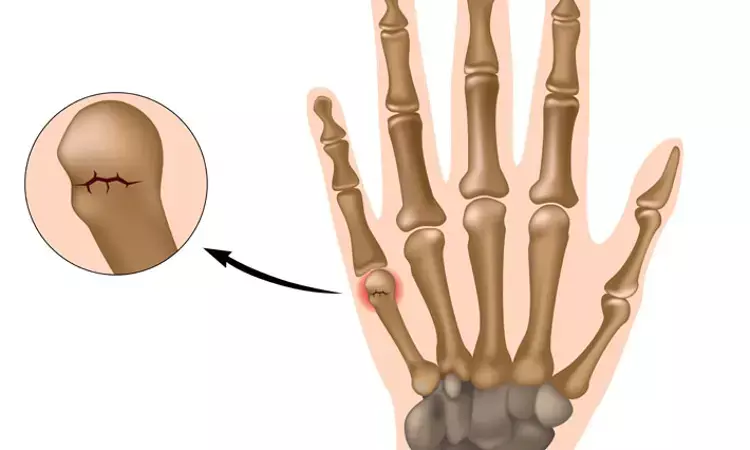- Home
- Medical news & Guidelines
- Anesthesiology
- Cardiology and CTVS
- Critical Care
- Dentistry
- Dermatology
- Diabetes and Endocrinology
- ENT
- Gastroenterology
- Medicine
- Nephrology
- Neurology
- Obstretics-Gynaecology
- Oncology
- Ophthalmology
- Orthopaedics
- Pediatrics-Neonatology
- Psychiatry
- Pulmonology
- Radiology
- Surgery
- Urology
- Laboratory Medicine
- Diet
- Nursing
- Paramedical
- Physiotherapy
- Health news
- Fact Check
- Bone Health Fact Check
- Brain Health Fact Check
- Cancer Related Fact Check
- Child Care Fact Check
- Dental and oral health fact check
- Diabetes and metabolic health fact check
- Diet and Nutrition Fact Check
- Eye and ENT Care Fact Check
- Fitness fact check
- Gut health fact check
- Heart health fact check
- Kidney health fact check
- Medical education fact check
- Men's health fact check
- Respiratory fact check
- Skin and hair care fact check
- Vaccine and Immunization fact check
- Women's health fact check
- AYUSH
- State News
- Andaman and Nicobar Islands
- Andhra Pradesh
- Arunachal Pradesh
- Assam
- Bihar
- Chandigarh
- Chattisgarh
- Dadra and Nagar Haveli
- Daman and Diu
- Delhi
- Goa
- Gujarat
- Haryana
- Himachal Pradesh
- Jammu & Kashmir
- Jharkhand
- Karnataka
- Kerala
- Ladakh
- Lakshadweep
- Madhya Pradesh
- Maharashtra
- Manipur
- Meghalaya
- Mizoram
- Nagaland
- Odisha
- Puducherry
- Punjab
- Rajasthan
- Sikkim
- Tamil Nadu
- Telangana
- Tripura
- Uttar Pradesh
- Uttrakhand
- West Bengal
- Medical Education
- Industry
Intramedullary Single-Kirschner-Wire Fixation in Boxer's Fracture: surgical technique

The fracture of the fifth metacarpal neck (also called a boxer's fracture) is the most common fracture of the hand. Displaced fractures often result in volar angulation of the metacarpal head, shortening, and residual malrotation. Although many fractures can be treated with a splint only, surgery should be performed in patients with excessive volar angulation, relevant shortening, or rotational deformity.
Investigation was performed by Adrian Scale et al at BG Klinikum Unfallkrankenhaus Berlin gGmbH, Berlin, Germany. The video article has been published in “JBJS ESSENTIAL SURGICAL TECHNIQUES.”
For this procedure, the injured arm of the patient is placed on an arm table. The incision is made 1 to 2 cm longitudinally over the ulnar base of the fifth metacarpal bone. The cortical bone is opened with an awl, and a bent 1.6-mm Kirschner wire is inserted into the medullary canal. After reaching the fracture region, the fracture is anatomically reduced. The Kirschner wire is then advanced into the head of the fifth metacarpal, securing the reduction. Malrotation can be addressed in this stage by rotating the wire under fluoroscopic control. After ensuring anatomical reduction clinically and by fluoroscopy, the wire is shortened under the skin, followed by closure of the incision.A mid-hand brace for splinting is utilized.
Other surgical techniques include a similar procedure that involves the use of multiple Kirschner wires, plate fixation, transverse Kirschner wire pinning, and, less commonly, retrograde headless screw fixation.“
The main advantage of this technique is the preservation of the metacarpophalangeal joint and the minimal soft-tissue damage. Additionally, the use of a single Kirschner wire provides stability at low cost. With some experience, this surgery can be performed within 20 minutes” the authors commented.
Important tips shared by the authors are:
• Bending the Kirschner wire to ensure easy gliding in the medullary canal provides the opportunity to reduce the metacarpal neck once the wire is safely in the head.
• Aim distally as you open the cortical bone with the awl in order to facilitate the insertion of the Kirschner wire.• The primary reduction should be made manually, not by the wire. Subacute fractures and substantially displaced fractures require direct force for a satisfactory reduction, which cannot be achieved by rotation of the wire only.
• The cortical bone on the metacarpal head is very thin. Take care not to drive the Kirschner wire through the cortical bone and into the joint.
• Shorten the wire under the skin approximately 1 cm above the bone surface; this ensures easy removal and prevents skin irritation.
Further reading:
Intramedullary Single-Kirschner-Wire Fixation in Displaced Fractures of the Fifth Metacarpal Neck (Boxer’s Fracture) Adrian Scale, Andreas Kind et al JBJS ESSENTIAL SURGICAL TECHNIQUES 2022, 12(2):e20.00050(1-2) http://dx.doi.org/10.2106 / JB JS.ST.20.00050 Published outcomes of this procedure can be found at: Bone Joint J. 2019 Oct;101-B(10): 1263-71.
MBBS, Dip. Ortho, DNB ortho, MNAMS
Dr Supreeth D R (MBBS, Dip. Ortho, DNB ortho, MNAMS) is a practicing orthopedician with interest in medical research and publishing articles. He completed MBBS from mysore medical college, dip ortho from Trivandrum medical college and sec. DNB from Manipal Hospital, Bengaluru. He has expirence of 7years in the field of orthopedics. He has presented scientific papers & posters in various state, national and international conferences. His interest in writing articles lead the way to join medical dialogues. He can be contacted at editorial@medicaldialogues.in.
Dr Kamal Kant Kohli-MBBS, DTCD- a chest specialist with more than 30 years of practice and a flair for writing clinical articles, Dr Kamal Kant Kohli joined Medical Dialogues as a Chief Editor of Medical News. Besides writing articles, as an editor, he proofreads and verifies all the medical content published on Medical Dialogues including those coming from journals, studies,medical conferences,guidelines etc. Email: drkohli@medicaldialogues.in. Contact no. 011-43720751


